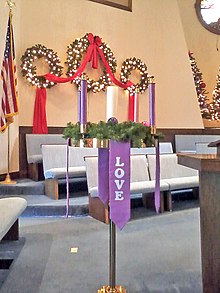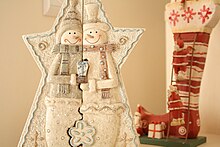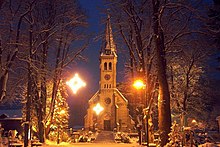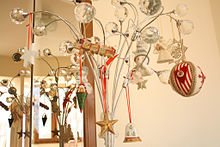



A Christmas decoration is any of several types of ornamentation used at Christmastide and the greater holiday season. The traditional colors of Christmas are pine green (evergreen), snow white, and heart red. Gold and silver are also prevalent, as are other metallic colours. Typical images on Christmas decorations include Baby Jesus, Mother Mary, angels, Father Christmas, Santa Claus, and the star of Bethlehem. Advent wreaths, nativity scenes, illuminations, and Moravian stars are popular Christmas decorations.[1]
In many countries, such as Sweden, people start to set up their Advent and Christmas decorations on the first day of Advent.[2] Liturgically, this is done in some parishes through a Hanging of the Greens ceremony.[3] In the Western Christian world, the two traditional days when Christmas decorations are removed are Twelfth Night and if they are not taken down on that day, Candlemas, the latter of which ends the Christmas-Epiphany season in some denominations.[4] Taking down Christmas decorations before Twelfth Night, as well as leaving the decorations up beyond Candlemas, is historically considered to be inauspicious.[5][6]
- ^ "The Putz and Illumination". Moravian Church. November 19, 2018. Retrieved December 3, 2023.
- ^ Michelin (October 10, 2012). Germany Green Guide Michelin 2012–2013. Michelin. p. 73. ISBN 9782067182110.
Advent – The four weeks before Christmas are celebrated by counting down the days with an advent calendar, hanging up Christmas decorations and lightning an additional candle every Sunday on the four-candle advent wreath.
- ^ Rice, Howard L.; Huffstutler, James C. (January 1, 2001). Reformed Worship. Westminster John Knox Press. p. 197. ISBN 978-0-664-50147-1.
Another popular activity is the "Hanging of the Greens," a service in which the sanctuary is decorated for Christmas.
- ^ "Candlemas". British Broadcasting Corporation. Retrieved April 9, 2014.
Any Christmas decorations not taken down by Twelfth Night (January 5th) should be left up until Candlemas Day and then taken down.
- ^ Raedisch, Linda (October 1, 2013). The Old Magic of Christmas: Yuletide Traditions for the Darkest Days of the Year. Llewellyn Publications. p. 161. ISBN 978-0-7387-3450-7. Retrieved April 9, 2014.
- ^ McGregor, Kate (November 30, 2023). "It's Bad Luck To Take Your Tree Down Before January 6". AOL.
According to the tradition of the 12 days of Christmas (explained above), January 6 is the earliest you should be taking down your Christmas tree. According to the legend, bad luck will befall those who stop the Christmas cheer any earlier.